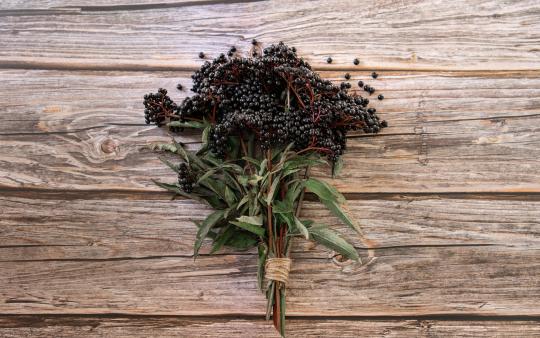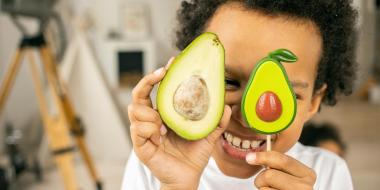When my daughter was born, to honour her birth, I knew I wanted to plant a tree steeped in tradition and full of healing power. Sambucus nigra, or elderberry, seemed the appropriate choice. Long revered for its exceptional and multi-faceted healing gifts, its deep purple berries and clusters of tiny white flowers intertwined with mythology, elderberry has been used for centuries throughout the world.
In folklore elder trees often play a sacred role. It was believed that the power of the Elder Mother turned the tree’s natural gifts of flowers, berries, and wood into blessings. Sambucus nigra offered protection from witches, evil, and calamity, and it was a particularly good omen if an elder grew near a dwelling, as being near to an elder tree would protect the household.
In The Book of Herbs, by Rosalind Northcote, elderberry’s global esteem and multitudinous applications are thoroughly extolled. Russians believe that elder trees drive away evil spirits, while Bohemians visit elder trees with spells to take away fever. Sicilians think that elder branches will kill serpents and drive away robbers better than any other, and Serbs introduce a stick of elder into their wedding ceremonies to bring good luck. In England it was thought that the elder tree was never struck by lightning; and a twig of it tied into three or four knots, and carried in the pocket, was a charm against rheumatism. A cross made of Elder, and fastened to cow-houses and stables, was supposed to keep all evil from the animals.1
And in Hans Christian Andersen’s fairy tale, Little Elder Tree Mother, a little boy who catches a cold is healed by the elder mother, who comes out of the pot of elder tea! Today, Sambucus nigra is still highly revered as one of our most powerful herbs with abilities to prevent and treat colds, influenza, and more.
Elderberry (Sambucus Nigra): a primer
Family: Adoxaceae
Common name: Elder, American elder, elderberry
Parts used: Bark, berries, flowers, and leaves
Taste: Berries: sour; flowers: bitter/sweet
Energy: Dry, cool
Active constituents
Berries: Flavonoids, invert sugar, fruit acids, vitamins A & C.
Leaves: Triterpenes, cyanogenic glycosides (sambunigrin), flavonoids, tannins
Flowers: Flavonoids (quercetin, rutin), triterpenes, phenolic acids, anthocyanins, vitamin C, free fatty acids (linoleic, linolenic, palmitic acid), tannins, essential oil.
Herbal actions
Berries: Anti-catarrhal, antioxidant, antiviral, diaphoretic, laxative.
Leaves: Externally—emollient, vulnerary; internally—purgative, expectorant, diuretic, diaphoretic.
Flowers: Diaphoretic, diuretic.
Bark: Purgative, emetic, diuretic.
System tropism: Lungs, immune, liver (flowers)
Contraindication: Not for those with tissue transplants using immunosuppressive drugs
Dosage
Tincture (1:5)
Long term (3x daily): Adult: 5–10 ml; children: 2–3 ml.
Acute (3x daily) for children:
- infants: 0.5 mL
- < 4yrs: 1–2 mL
- < 6yrs: 2–3 mL
- < 8yrs: 3–4 mL
- < 10yrs: 4–5 mL
- > 10yrs: 5mL
Tea
For both acute and long term: 1–2 tsp dried berries. Add 8 oz hot water, steep for 10 minutes 3c/day.
Syrup
Long term: ½–1 tsp for kids, ½–1 tbsp for adults. Acute: every 2–3 hours until symptoms disappear
What is Elderberry good for?
Sambucus nigra is the best-known herb in Western herbal medicine for immune support and nourishment, and can boast a number of health benefits.
Perspiration
Elderberry flowers promote perspiration in the early stages of influenza, especially when combined with Mentha piperata (peppermint). It is supportive in the removal of waste and toxins through both the skin and kidneys.
Fever reduction
Elderflower is especially helpful for fevers where a child feels hot, is bright red and restless, and is not sweating. It is also very refreshing on a warm day!
Preventing infection
Research has demonstrated the ability of elderberry to prevent upper respiratory infections and shorten the duration of a cold or flu.2 In some recent studies, Sambucus nigra syrup reduced the severity of flu symptoms and shortened their duration by about four days.3,4 The H1N1 inhibition activities of elderberry flavonoids compare favourably to the known anti-influenza activities of oseltamivir (Tamiflu®) and amantadine.5
Inflammation
Beneficial flavonoids cool and repair inflamed tissues, reducing both inflammation and oxidative stress.6
Virus protection
Research performed by Madeleine Mumcuglu, PhD, found that the influenza virus forms tiny spikes (hemagglutinins) laced with an enzyme (neuraminidase) that helps the virus to penetrate the cell walls of a healthy organism. Mumcuglu found that the active ingredients in elderberries disarm the viral neuraminidase enzyme within 24–48 hours, thus preventing the virus from entering and further replicating in the cells.7 Sambucus berries contains several compounds that have also been demonstrated to reduce ACE2 binding.8,9
Elderberry syrup recipe
Ingredients
-
1½ cups freshly picked black elderberries or ⅔ cup dried
-
3½ cups filtered water
-
2 tbsp ginger root, peeled and sliced
-
1½ tbsp ground cinnamon
-
1 tsp ground gloves
-
1 cup of raw, local honey
Instructions
- Add all ingredients, except honey, to a medium-sized saucepan. Bring to a boil.
- Reduce heat and let simmer for 3–4 hours, stirring occasionally, until liquid is reduced by half.
- Remove from heat. Strain liquid to remove solids. Let cool.
- Once completely cooled, add honey and mix well. Decant into an airtight container. Keep refrigerated for up to a month. For dosing see above.
Tonsillitis Gargle
Ingredients
-
1 tbsp elderberry fruit juice
-
1 tbsp sumac extract
-
1 tsp echinacea root extract
Instructions
Combine ingredients and gargle, as needed.
You may also enjoy: Your Winter Wellness Kit: Beat Cold and Flu Season, Vitamins and Supplements for Winter Wellness, and The Health Benefits of Elderberry.
For references visit ecoparent.ca/TWF/WINTER2021.






